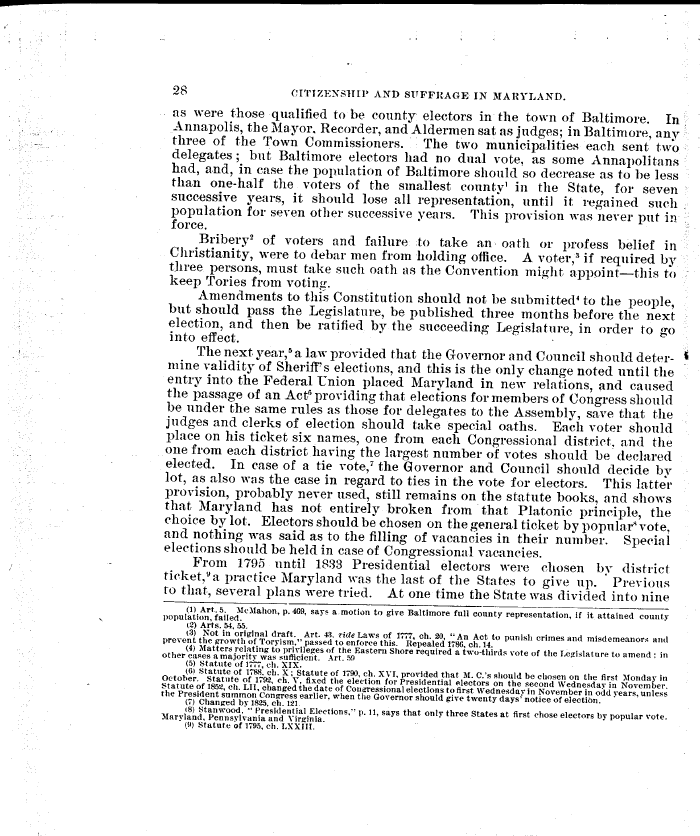|
28 CI'1'I'/.E\SIIII' AND SUFFRAGE IN MARYLAND.
as were those qualified to he county electors in the town of Baltimore. In
Annapolis, the Mayor. Recorder, and Aldermen sat as judges; in Baltimore,
any
three of the Town Commissioners. The two municipalities each sent two
delegates; but Baltimore electors had no dual vote, as some Annapolitans
had, and, in case the population of Baltimore should so decrease as to be
less
than one-half the voters of tile smallest county' in the State, foi- seven
successive years, it should lose all representation, until it regained such
_ - population for seven other successive years. This provision was never
put in
force.
Bribery2 of voters and failure .to take an oath or profess belief in
Christianity, were to debar men from holding office. A voter,' if required
by
three persons, must take such oath as the Convention (night appoint-this to
keep Tories from voting.
Amendments to this Constitution should not be submitted' to the people,
but should pass the Legislature, be published three months before the next
election, and then be ratified by the succeeding Legislature, in order to go
into effect. .
The next year,5a law provided that the Governor and Council should deter-
mine validity of Sheriff's elections, and this is the only change noted
until the
entry into the Federal Union placed Maryland in new relations, and caused
tile passage of an Act'' providing that elections for members of Congress
should
be under the same rules as those for delegates to tile Assembly, save that
the
judges and clerks of election should take special oaths. Each voter should
place on his ticket six names, one from each Congressional district, and the
one from each district. having the largest number of votes should be
declared
elected. In case of a tie vote,' the Governor and Council should decide by
lot, as also was the case in regard to ties in the vote for electors. This
latter
provision, probably never used, still remains on the statute books, and
shows
that Maryland has not entirely broken from -that Platonic principle, tile
choice by lot. Electors should be chosen on tile general ticket by popular"
vote,
and nothing was said as to the filling of vacancies in their number. Special
elections should be held in case of Congressional vacancies.
- From 179.5 until 1833 Presidential electors were chosen by district
ticket,ya practice Maryland was the last of the States to give lip. Previous
to that, several plans were tried. At one time the State was divided into
nine
(1) Art.. 5. \fc\Ialion, p.469, says a.motion to give Baltimore full county
representation, if it attained county
population, failed.
(2) Arts. 54, 55.
(3) Not in original draft. Art. 4.3. vide Laws of 1777, ch. 20, "An Act to
punish crimes and misdemeanors and
prevent the growth of Toryism," passed to enforce this. Repealed 1786,
ch.14.
(4) Matters relating to privileges of the Eastern Shore required a
two-thirds vote of the Legislature to amend ; in
other cases a majority was sufficient. Art. 59
(5) Statute of 17 7 7, ch. aIx.
(6) Statute of 1788. ch. 7C ; Statute of 1790, ch. NVI, provided that M.
C.'s should be chosen on the first Monday in
October. Statute of 179'2, ch. V, fixed the election for Presidential
electors on the second Wednesday in November.
- Statute of 1852, ch. 1.11, changedthe date of Congressional elections
tofirst Wednesday in November in odd years, unless
the President summon Congress earlier, when the Governor should give twenty
days' notice of electibn.
(7 ) Changed by 1815, ch. 121.
~8) Stanwood. •• Presidential Elections," p. 11, says that. only three
States at first chose electors by popular vote.
3laryland, Pennsylvania and Virginia.
(9) Statute of 1795, ch. LSIIII.
|

